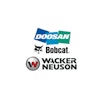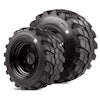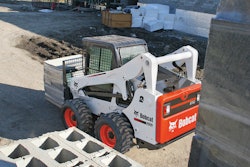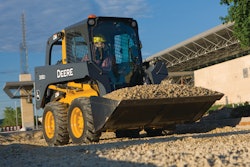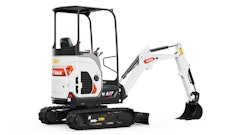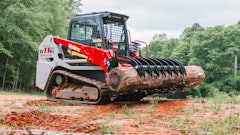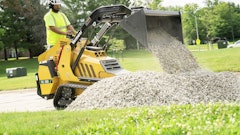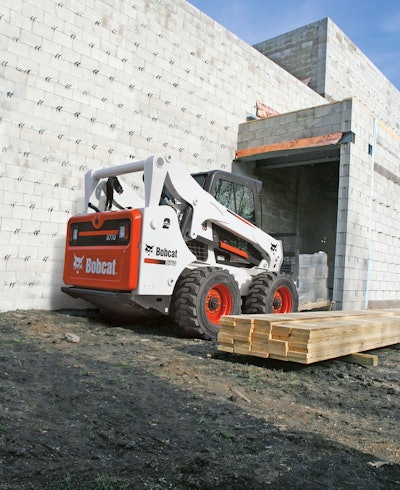
The way a skid steer is controlled can have a significant impact on your customer's experience with the machine and ultimately, his opinion of your rental business. Understanding the different types of controls available on today's machines and their importance to your customers can help you tailor your fleet to meet their expectations.
Popular skid steer control options
Dual-Lever Foot Control
Invented by Bobcat 50 years ago, this type of skid steer control system consists of dual steering levers that control the drive functions, while dual foot pedals control the loader lift and tilt. Often referred to as “standard” controls, they remain a popular choice today.
H-Pattern Control
With this control function, the operator only needs to use his/her hands, explains Jamie Wright, Terex Construction Americas. When driving, this control is the same as the dual-lever foot control unit as stated above; however, the boom and bucket function work differently. This control has hinged handles on the levers, or at the base of the levers, that when pulled toward the operator or pushed away operate the boom and bucket function. The left lever lowers the boom when pulled toward the operator; when the lever is pushed away from the operator, it raises the boom. The bucket tilt function works the same way as the lift, only it is positioned on the right side - push out for bucket dump and pull in for bucket curl.
Many manufacturers offer the option to switch between control modes. Bobcat, for example, offers the Advanced Control System (ACS). On equipped models, the operator can flip a switch and go from standard to H-Pattern controls. “This is often the ideal choice for rental inventories,” says Mike Fitzgerald at Bobcat, “because of the flexibility and versatility it offers.”
ISO Joystick Control
This control option operates completely differently than the previous two control options. Joystick control is either hydraulic or electric-over-hydraulic control, says Wright. The left joystick drives the unit, while the right joystick controls the boom and bucket. The boom and bucket functions are in the right joystick control.
The latest and (to some) greatest
Many of today's skid steers offer selectable controls to manipulate between ISO and H-Pattern control options to appeal to a larger customer base; however, H-Pattern controls are becoming less popular, says Wright at Terex Construction Americas. "Also, the incorporation of attachment control at the joystick is popular. This feature gives the operator complete control over complex attachments."
Fitzgerald notes that selectable joystick controls offer some key features:
- Precise Joystick Responses - Controls respond to forward drive, reverse drive and steering changes. They also react to slow machine operation, high-range turning and starting/stopping.
- Speed Management - Matches the operator’s travel speed to operation requirements for optimizing attachment performance. It provides precise control of machine movements in tight areas and adjusts the default speed setting.
- Horsepower Management - Automatically adjusts the drive system to maximize pushing and digging power without stalling the engine.
- Foot Throttle - Increases engine speed when needed since the operator’s feet are free of other controls.
- Fingertip Switches - Control attachment functions, speed management, horn and blinkers without the need to let go of the joysticks.
- Selectable Control Pattern – Operators can select ISO or H-Pattern hand controls at the flip of a switch to satisfy their personal preference.
- Steering Drift Compensation - The system reduces steering drift, provides side-shift operation for trenchers and planers, and adjusts for surface variations such as crowned roads.
- Drive Response - Adjusts to jobsite conditions by setting the drive and steering responsiveness to one of three settings.
“All these different features give you the flexibility to accommodate the needs of any operator,” says Fitzgerald.
Personal preferences vary
Despite all the latest bells and whistles available on today’s skid steers, many operators still prefer the simplest, tried and true method of controlling their machine. As such, rental businesses need to assess the preferences of their customer base when outfitting their skid steer fleet.
Kelly Moore at Gehl says the type of control utilized in a skid steer is primarily driven by personal customer preference, based on past experiences. "Whether the customer is a smaller operation with few employees to a larger business with many employees, the experiences and acclimation to the type of controls is usually most important when it comes to renting one or more skid loaders," he says.
Wright agrees. "Most customers want a control option their employees are accustomed to operating. There seem to be more contractors who wish to accommodate the next generation of operators, so we are seeing more diversity in control options in our customers’ loader fleets. Rental companies typically choose the control options that are more regionally accepted."
While younger generations enjoy selectable joystick controls, some contractors, however, still favor mechanical linkages. "There seems to be a feeling among some of the mature operators that mechanical linkages will give them a better feel and control of the machine," Wright explains. "Again, it depends upon what the operator is used to running. Mechanical linkages have a longer throw to get the unit to do what the operator wants it to, which increases the range of motion it takes - this makes the operator perceive that they have better feel and control over the loader."
He adds, "Mechanical linkage is currently less expensive than joystick due to the lack of technology and testing required to dial-in the joystick controls. But, maintenance is minimal with the joystick control due to very few moving parts, whereas mechanical linkage offers many pivot points, some of which need to be greased to increase the life of the moving part.”
Fitzgerald says the vast majority of machines going into rental are still sold with standard controls. “It’s the least expensive and most customers are familiar with those controls,” he says, admitting their numbers are dwindling. "Every year we sell more skid steers with joystick than the year before. Younger operators are familiar with joysticks," he says. "Also, lots of companies are downsizing from larger equipment and those operators who are coming off larger pieces of equipment want pilot-operated joystick controls."
Easy on the operator
Despite those who still enjoy the feel of a longer throw, the latest control options offer simplicity and less stress on the operator. "Joystick seems to be the easiest for people to understand if they have limited operating experience," Wright says. "The range of motion is minimal, and if an operator has bad ankles, hips or knees, foot pedals are not the right choice. Joystick operation is smooth and concise, and the speed of the unit can be reduced by manipulating the engine speed, which will slow things down while the operator is getting accustomed to the controls. As it takes very little energy or effort to operate a joystick-controlled loader, at the end of a long work day, an operator won’t feel as fatigued."
He adds, “As with any type of equipment, operators should be trained prior to use.”
Moore at Gehl agrees with Wright that joystick controls are likely the best choice for novice users. "For the majority of weekend renters, the simpler the controls can be, the easier and safer the operating will be.”
As we all know, the bottom line in equipment rental is customer satisfaction and that means adjusting to meet the needs of all equipment operators. “In today’s world, it’s more and more important to keep operators happy,” says Fitzgerald. “It’s increasingly difficult to find equipment operators, and they’ll move from one company to another if they don’t like the equipment.”

